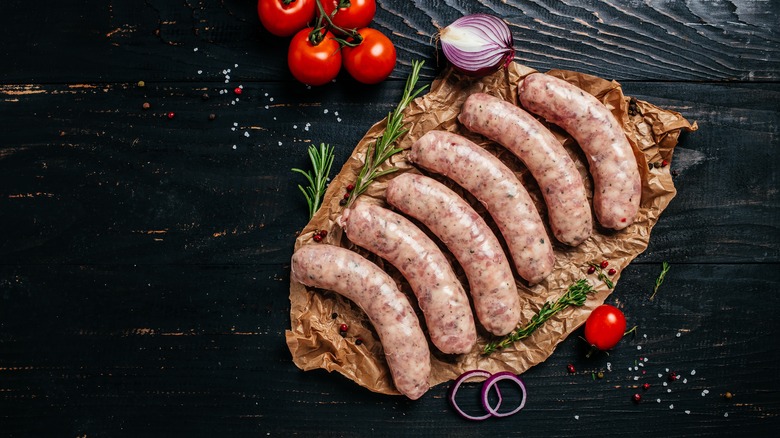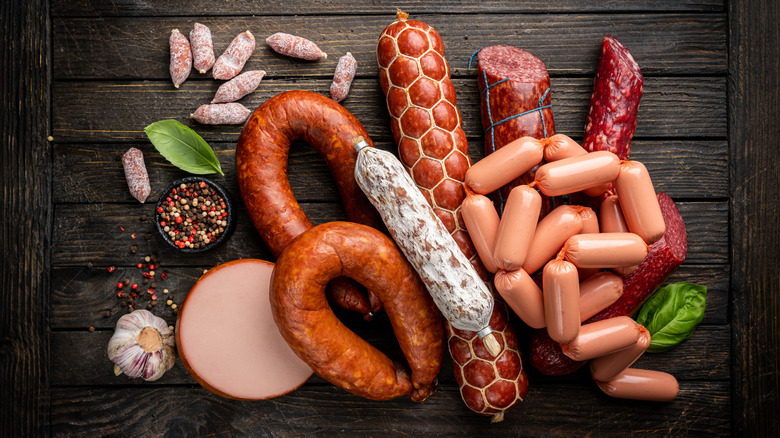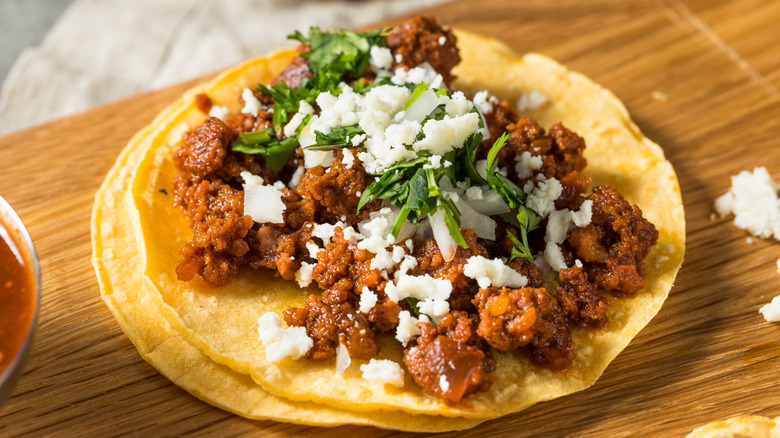Can You Actually Taste Sausage Casings?
Whether you like a couple veal and turkey breakfast sausages in the morning, a snack of Portuguese chorizo rolls, or a plain old hot dog on the Fourth of July, sausage is a beloved staple around the world. Yet those of us who aren't sausage-makers might have no idea how it's made, and even say we "don't want to know how it gets made." But at a time when we're paying more attention to what we eat and where it comes from, it may be time to find out what sausage casings are actually made of — and whether or not they contribute to a sausage's taste.
We all know that casings are used to help the meat, fat, and spices inside a sausage link maintain their shape. They've been used for thousands of years, and the materials used to make them have evolved over the centuries. But are they merely functional, or can you taste the difference between your sausage with a casing or without? And do different kinds of casings have different flavors?
Generally speaking, the answer to both of those questions is no. The majority of sausage casings are largely flavorless, but this doesn't mean that they have no bearings on the sausage-eating experience. Different types of casings can have a big impact on the texture of your sausage, if not the taste.
Different types of sausage casings
Sausage casings can vary widely. Natural casings, made from the intestines of animals like cows or pigs, are the most traditional style. The collagen in the intestines allows the casings to be stretched without breaking. Sausages made with natural casings may use the same animal for both the casing and the meat inside it, or they may not — your pork sausage might come with a beef casing.
On the other hand, synthetic casings are generally made from collagen derived from animal hides, which is fully edible. They may also be made from cellulose, which is not. Cellulose is used for breakfast sausages and other types that are eaten without the casing. Both natural and animal-derived synthetic casings have a collagen base, and collagen doesn't really have flavor. (This is why collagen is often used in protein powders as a neutral drink or smoothie additive.)
Some people prefer the flavor of natural casings to synthetic casings, but you would have to be a dedicated sausage aficionado to tell the difference from taste alone... though the texture of natural casings is notably "snappier," making for a firmer texture when the sausage is bitten. Many sausage fans value this "snap," which is why you might see "natural casing" proudly displayed on some sausage products. There are also some plant-based casings available today, which are often made from materials like polysaccharide or alginate.
Should you remove sausage casings before eating?
While sausage casings definitely serve a purpose, not all of them should be left on when it's time to cook the meat. The packaging of sausage should clearly state if you are meant to remove the casings prior to consumption, which can be easily done by piercing the casing with a knife and squeezing the meat out. Removal is easier if you do it before cooking the sausage, rather than after.
Sausage labels will also state if the casing comes from a different animal than the meat itself, which may be useful to know. If, for example, you have chicken sausage in a pork casing, you may want to avoid serving it to anyone who doesn't consume pork. As previously mentioned, some sausages have non-edible plastic or cellulose casings, which should be noted on the package as well. Casings are commonly removed when cooking breakfast sausages or chorizo, or any time you may want to crumble your sausage, such as when making a pasta sauce or casserole. And if you buy your sausage at an independent butcher, rather than a grocery store, make sure to ask them if the sausages can be eaten skin-on.



